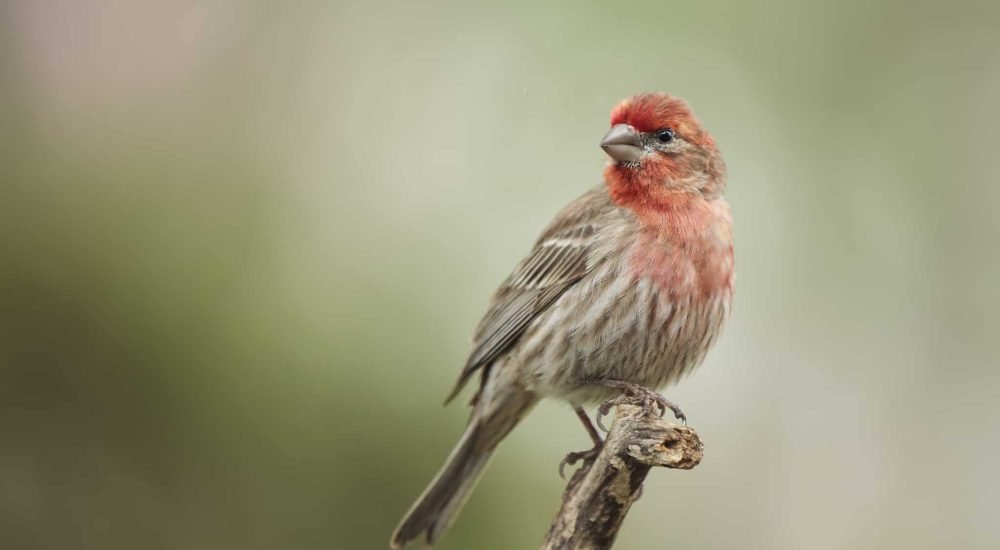
Want to learn more? This book on everything to do with Finches is a fantastic read!
Arizona is a southwestern state in the United States, widely renowned for the iconic Grand Canyon.
Arizona is also considered one of the Mountain States and is praised for its incredible variety of natural landmarks like Flagstaff, Saguaro National Park, and the Sonoran Desert landscape.
Arizona’s geographic location influences its fascinating climates that include semiarid, arid, and humid.
This diverse range of climates offers a wonderful home to all types of birdlife.
It may come as no surprise that Arizona is home to 31 state parks, and home to a magnificent 12 species of finches!
While you are most likely to observe the House Finch, you may only occasionally see the Pine Siskin. Below, you’ll find the fascinating qualities of each finch species!
Want to attract finches? Take a look at our article!
What Finches can be seen in Alabama?
Table of Contents
1. House Finch
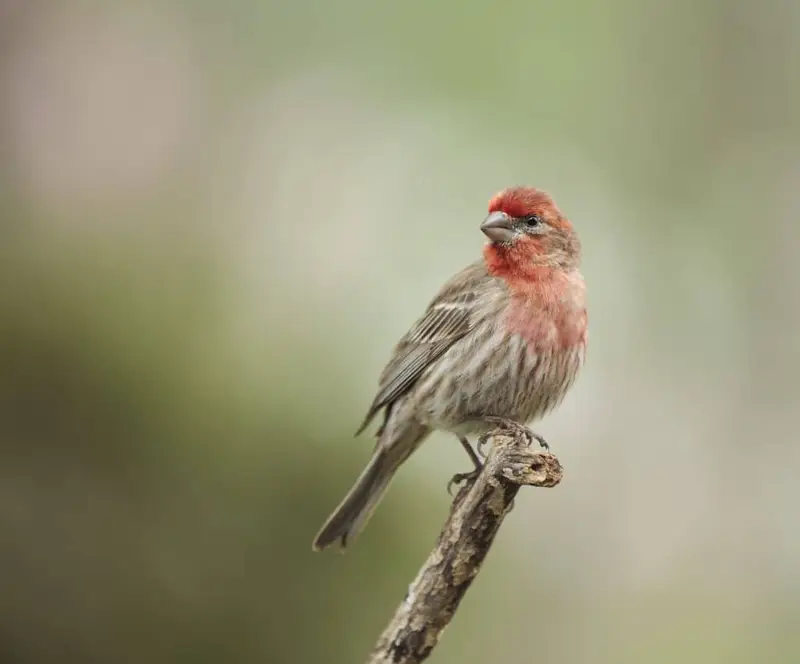
William Whitehead, XC629127. Accessible at www.xeno-canto.org/629127.
Fun Facts:
- A finch’s diet is dependent on the type of beak they have. House Finches have a seed feeding beak as seeds are their main source of food. The most popular seed for them is the black oil sunflower seed. They also eat certain types of flower buds and fruits, these incluce cherries and thistle.
- House Finches are only very small birds with a small weight range. They range from 16-27g and have only a tiny wingspan of 20-25cm.
House Finches are a smaller species of birds with relatively large beaks and long heads.
The males tend to vary in regard to their shades and intensities of red. They typically have red heads and upper chests with grayish-brown napes, backs, and wings with streaks on their sides.
Some males are even known to be yellow or orange, while females are an overall dull grayish-brown color.
Throughout Alabama, House Finches are abundant with low conservation concern. These birds are the most common in inland regions in all seasons.
They are known to take habitat in open woodlands, especially in close proximity to buildings and homes.
House Finches have also been known to frequent gardens and bird feeders.
House Finches are known to breed anywhere from early spring to late autumn, nesting in deciduous and coniferous trees building nests from stems, leaves, rootlets, and even feathers.
You’ll easily identify these finches by their sharp ‘cheep’ sound that is often heard in flight, and even when they are perched.
2. Purple Finch
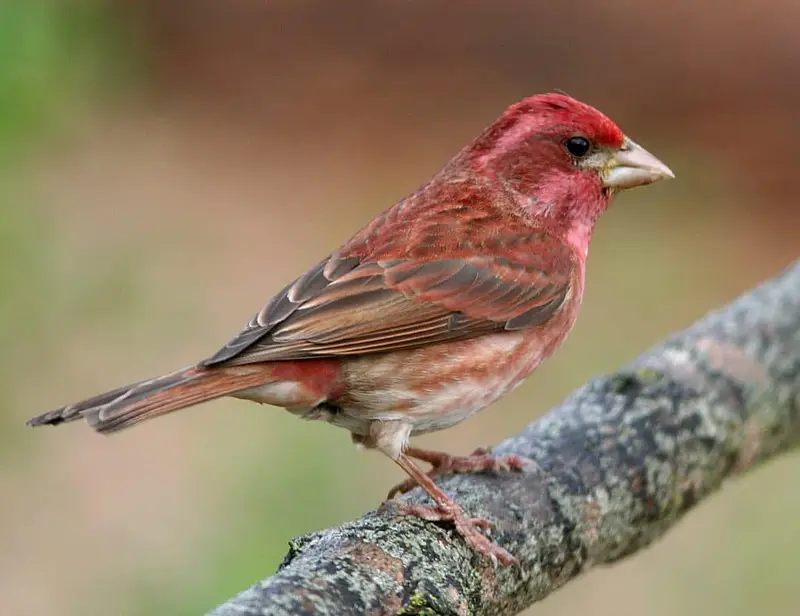
Peter Ward and Ken Hall, XC598463. Accessible at www.xeno-canto.org/598463.
Fun Facts:
- These birds have bills that are designed for breaking different seeds open. Their favourite seeds include black oil sunflower seeds and safflower seeds. They also enjoy eating nectar and occasionally consume flower buds.
- Purple Finches weigh just slightly more than House Finches at 18-32g. They also have very small wingspans which range from 22-26cm.
Purple Finches are medium sized finches known for their brilliant raspberry red color.
The adult male has a tie-dyed patterned crest, breast, back and rear. Females and immatures tend to be light brown on top with mostly white feathers on their underparts.
Purple Finches can be most readily seen during summer, and spotted during the winter, as the birds are migrating to warmer climates.
You’ll likely see these finches taking habitat in Alabama’s abundant coniferous and forests with openings.
During the winter months, they are also readily seen visiting suburban areas like backyard bird feeders.
These finches breed during the late spring and summer months, nesting in the crotches of conifer trees. Take note of the adult’s identifiable ‘tick’ call while in flight, as well as the ‘peewee’ sound of the immatures.
3. American Goldfinch
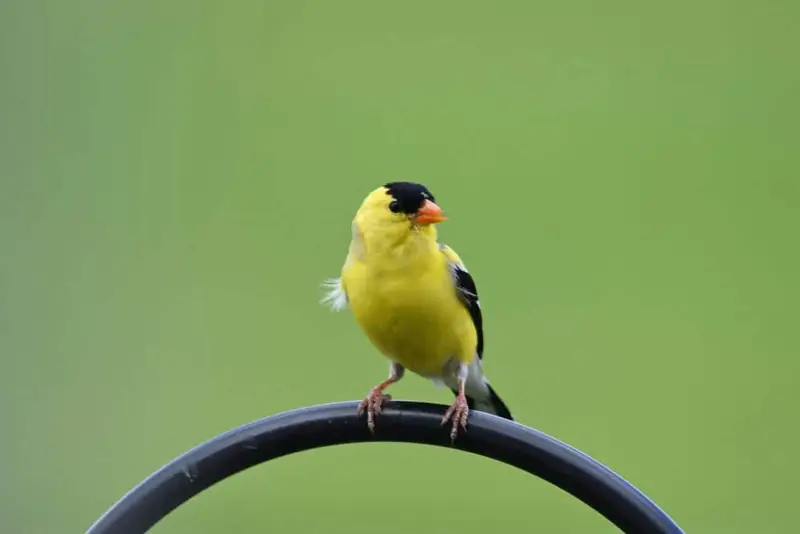
Russ Wigh, XC610948. Accessible at www.xeno-canto.org/610948.
Fun Facts:
- American Goldfinches have a beak designed for eating small seeds. Nyjer seeds being a favourite of theirs. They rarely eat anything outside of the seed family.
- These finches are slightly smaller than the other finches that we’ve looked at, weighing only 11-20g. They also have a very tiny wingspan which measure 19-22cm.
American Goldfinches are a particularly small species of finch, known for their sharp and pointed beaks.
Interestingly, the seasons influence the color of these birds. During the spring and summer, adult males are usually a bright yellow color with black foreheads and wings.
Females, however, are a pale yellow color on their underparts, but they are an olive color on their upperparts with distinctive bars on their wings.
During the winter though, the females are brown. You’ll find American Goldfinches throughout Alabama during all seasons.
They prefer to take habitat in fields with weeds and in floodplains where thistles are present.
Recently, they have also been known to take habitat in orchards and backyards, readily visiting feeders in the winter.
American Goldfinches breed mostly during the summer, although they have been known to breed into the autumn months.
They usually nest in shrubs in open settings. These finches are recognized for their unmistakable in-flight contact call that sounds like ‘po-ta-to-chip’.
4. Pine Siskin
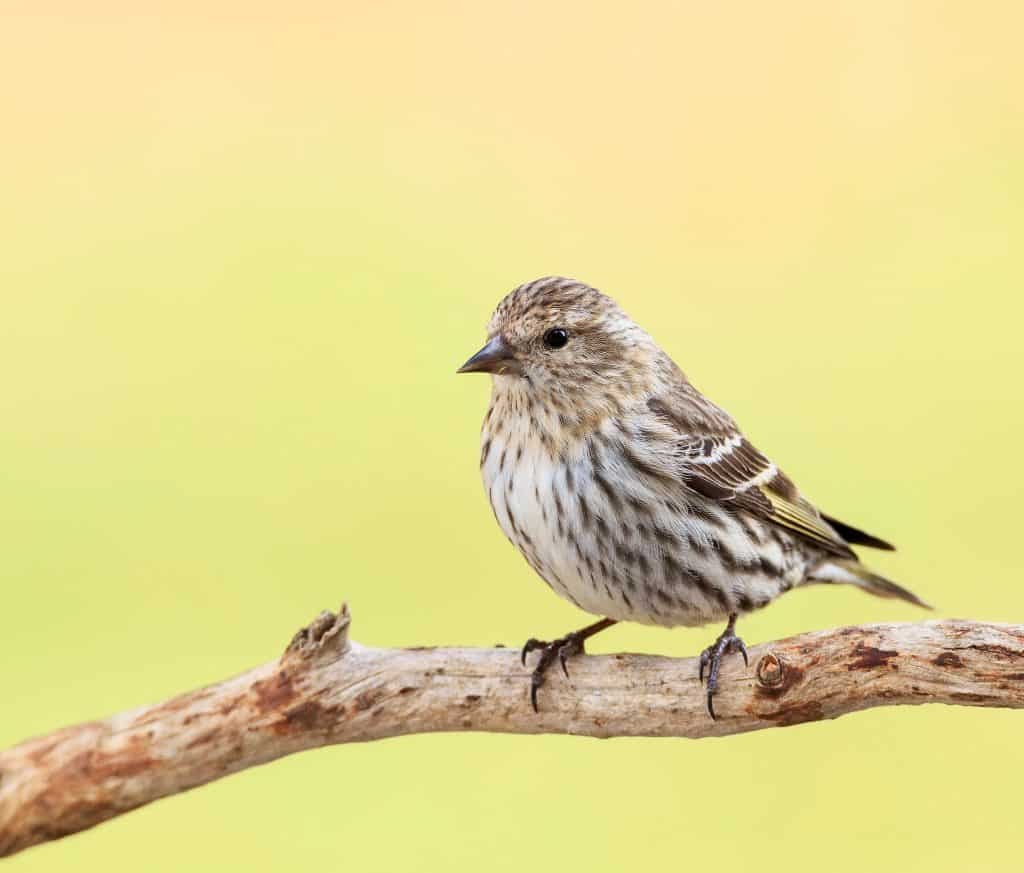
William Whitehead, XC595659. Accessible at www.xeno-canto.org/595659.
Fun Facts:
- These birds have beaks designed for eating seeds and, as the name suggests, they mostly eat seeds from the pine family. As well as seeds, they have also been known to forage for small insects, these insects are usually aphids.
- Pine Siskins are very similar in size to the American Goldfinch, weighing in at a range of 12-18g. Like other finches, they also have small wingspans of 18-22cm.
Pine Siskins are a small species of finch with sharply pointed bills, short tails, and long wings.
The finches are streaked brown, displaying yellow on their wings and tails.
These finches are fairly common in the Alabama region, taking habitat in open woodlands.
Pine Siskins are also known to frequent backyard feeders in close proximity to conifers. Breeding season for these finches heavily depends on an adequate food supply.
Pine Siskins have been known to breed during the early spring months, through the late summer.
They can even breed in cold temperatures, which is why food can heavily influence their breeding.
You can sometimes witness these birds in flocks with other finches like goldfinches.
Pine Siskins are particularly vocal, and you’ll recognize them by their unique buzzing sound that has been compared to the sound of a zipper.
5. Red Crossbill
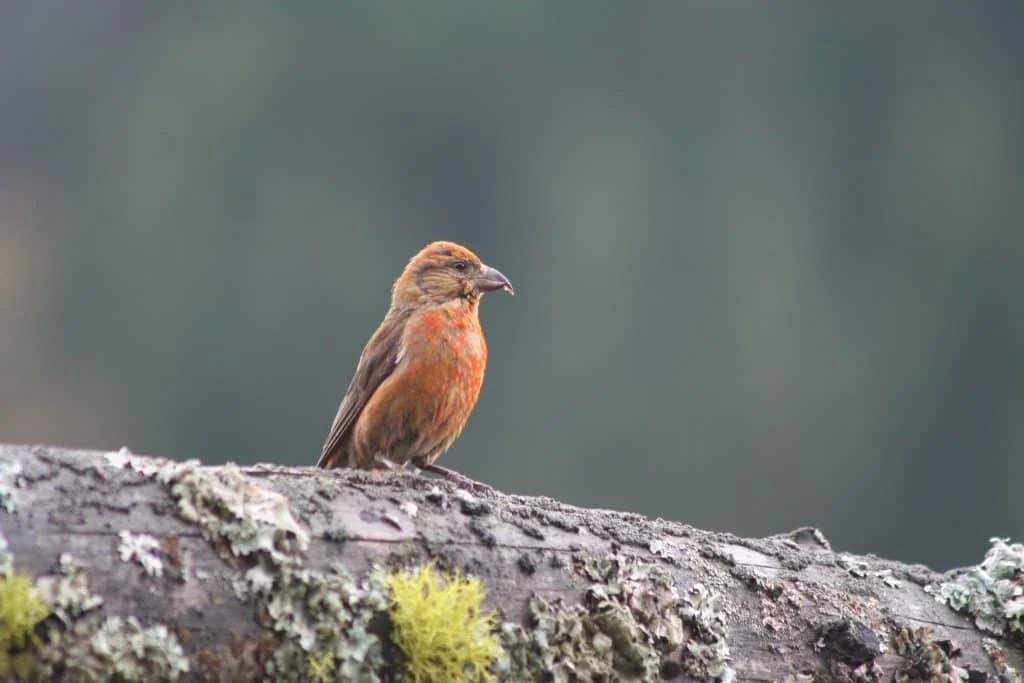
Stanislas Wroza, XC626649. Accessible at www.xeno-canto.org/626649.
Fun Facts:
- The Red Crossbills mostly feed on seeds, particularly pine seeds. During the summer they will also sometimes eat insects.
- Due to their varied and unstudied sizes, there is no average weight range for this bird.
Red Crossbills are small birds recognized by their distinct crossed bill and large heads.
The adult males are a pale red-orange color with grayish-brown highlights. Females, though, are generally a pale, olive-yellow color. Juveniles resemble a more dull version of the females, although they are streakier.
Interestingly, Red Crossbills are recognized as having moderate conservation concern though they are still present during all seasons in Alabama.
They like to take habitat in Alabama’s mature coniferous woodlands where they nest inside dense foliage.
Take note that the Red Crossbill’s breeding habitats can be quite unpredictable!
Some of these finches breed in the winter and spring months, however they have been known to breed in any season. These are very social birds, so it should come as no surprise if you see them out and about!
You’ll recognize Red Crossbills due to their loose trills and warbles that somewhat mimic an in-flight call. Be aware that it is the male finch that has this call.
6. Lesser Goldfinch
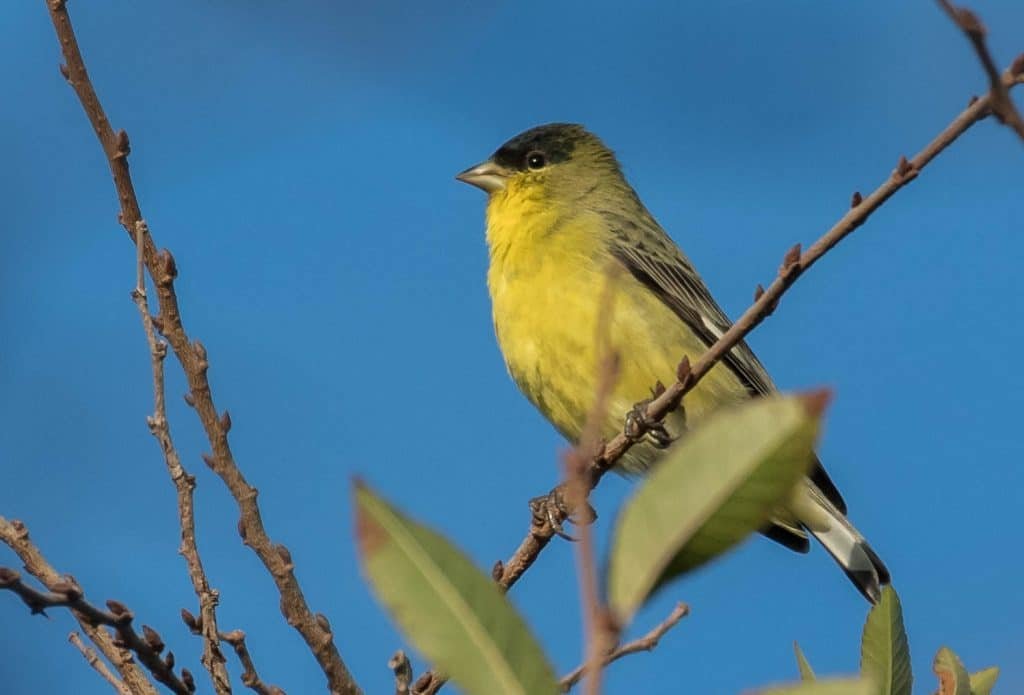
Paul Marvin, XC549158. Accessible at www.xeno-canto.org/549158.
Fun Facts:
- These finches mostly eat seeds however they will also consume fruit from time to time, such as elderberries. In summer they will also eat certain types of flowers.
- These finches are the smallest of the species that we have previously looked at, they weigh only 8-11.5g with a wingspan of 15-20cm.
Lesser Goldfinches are a notably small species of bird known for their small heads, and sharply pointed, blackish bills.
The adult males of this species typically have green or black backs. Females, however, have olive colored backs, pale yellow underparts, black wings, and white wing bars.
Lesser Goldfinches prefer to take habitat in open country areas, open woods, and have been known to take habitat in gardens.
These finches can be spotted in dry country close to water or on woodland edges. In Alabama, you can spot small flocks of these birds in weedy fields near streams as they feed on seeds and insects.
These finches are known to breed in the early spring and mid-autumn months, nesting in the vertical fork of twigs in trees or shrubs. Lesser Finches have an interesting sound resembling a medley of twittering notes.
7. Scaly-breasted Munia

Jerome Chie-Jen Ko, XC631467. Accessible at www.xeno-canto.org/631467.
Scaly-breasted Munias are small birds known for their interesting scaly patterns.
The adults of this species are a dark brown color above with white underparts, though a dark scaly pattern adorns their bellies.
The immatures are an overall brown color with pale underparts. The Scaly-breasted Munia is no stranger to southern states, and they have been observed numerous times throughout Alabama.
These birds prefer to take habitat in grasslands, gardens, fields, and agricultural areas. They can often be seen in small flocks with other species.
They typically breed in the spring and summer months. They usually build their nests from grass and leaves in small shrubs and bushy trees. You’ll recognize these birds by their ‘chee/ba-hee’ call.
8. Evening Grosbeak
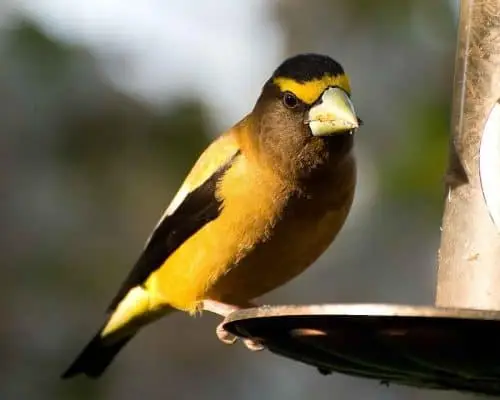
Doug Hynes, XC612610. Accessible at www.xeno-canto.org/612610.
Evening Grosbeaks are a particularly large species of finch known for their stocky build and their strong, but pale colored bills.
Adult males are a bold black color on their heads, that fades into their bright yellow colored underparts.
Their wings are mostly black and accented with white feathers. Females and juveniles are gray with faint white patterns on their wings.
Evening Grosbeaks are occasional visitors spotted throughout Alabama as their population is steadily declining.
These finches prefer to take habitat in woodlands and forested regions at high elevations.
They can typically be seen in the late autumn, winter, and spring months. Grosbeaks tend to break in mid-spring, nesting in high trees or large shrubs.
Flocks of these finches have been known to visit backyard feeders for sunflower seeds.
Evening Grosbeaks can be identified by their descending ‘chee-er’ sound that starts out at a high octave, but then falls in tone.

More Articles.
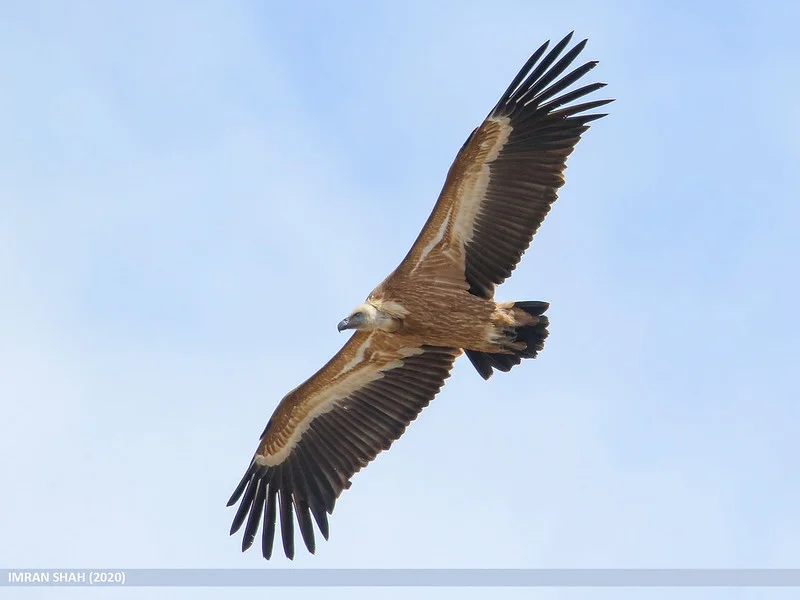
What Birds of Prey can be seen in France? (10 Species with Pictures and Sounds)
France is filled with numerous birds of prey. Its variable habitat from the mountains of
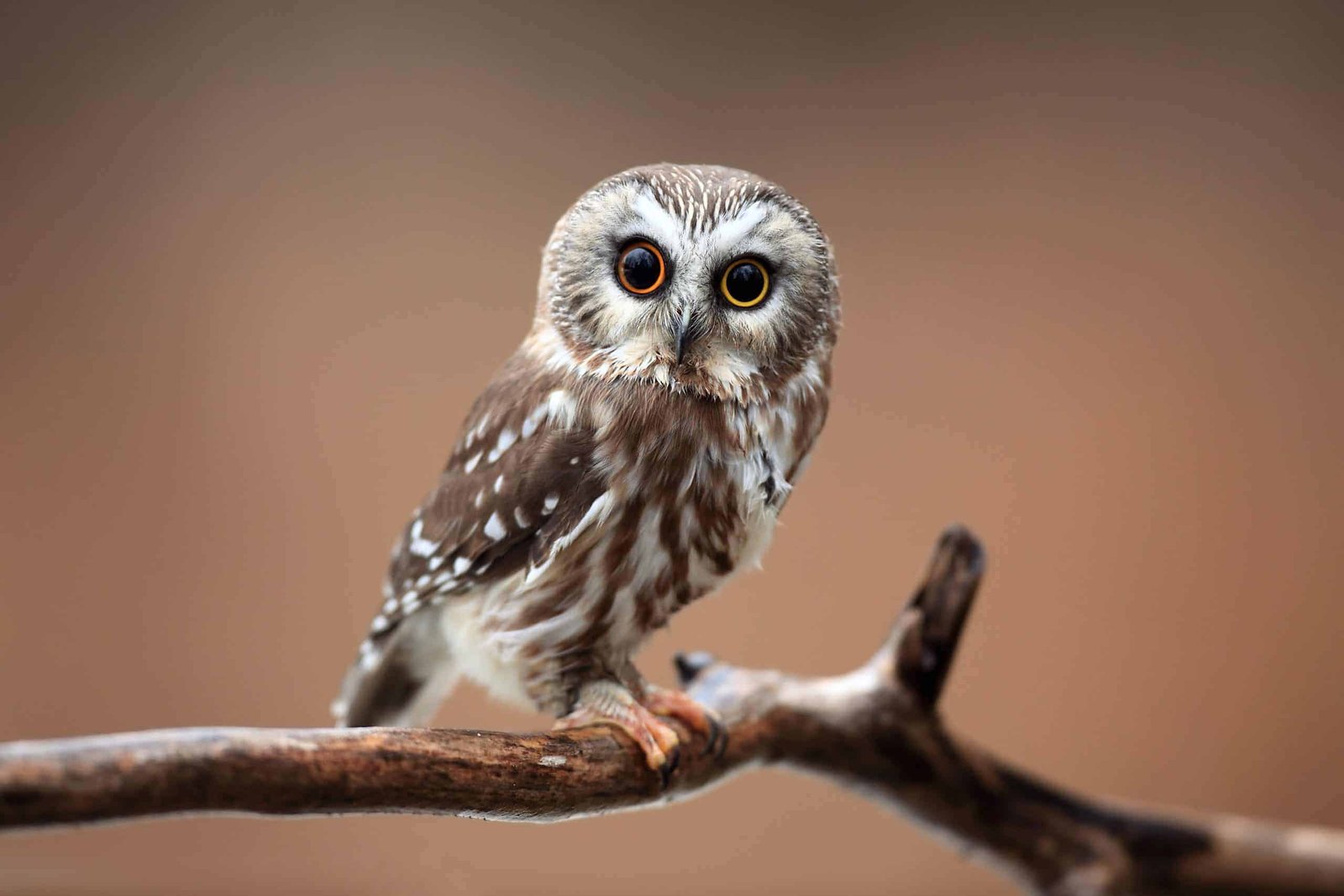
What Does It Mean To See An Owl During the Day?
Many believe that seeing an owl during the day can have fairly large implications and
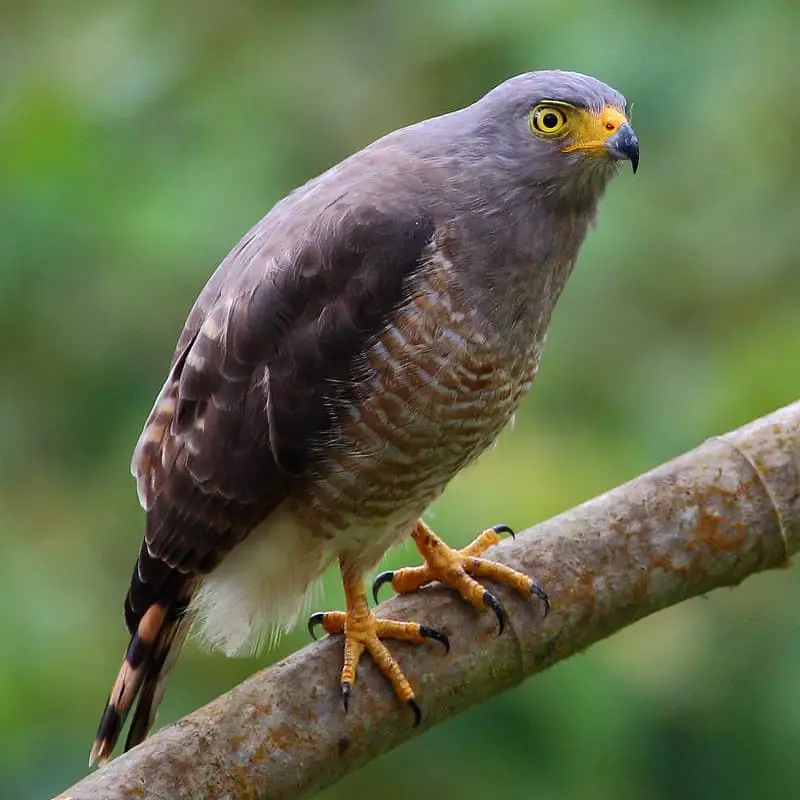
Differences between Hawks, Falcons and Eagles (8 Differences with Pictures and Sounds)
The difference between Hawks, Falcons, and Eagles can be difficult to spot for bird watchers

About Us
We are avid bird-watchers who recently retired, allowing us more time to travel the world. Fortunately, we have managed to visit numerous countries around Europe, Asia, and America. Watching and photographing birds has been a passion for many years and we are making the most of the extra time on our hands!
